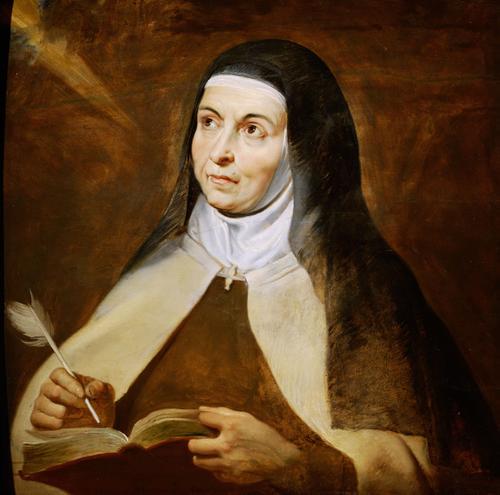
Teresa, of Jesus
Monday, May 4, 2015
Rogelio Zelada
On the cold morning of March 28, 1515, in the walled city of Avila — Avila del Rey, of the Loyalists and the Knights, as proclaimed on its shield — Teresa Sánchez de Cepeda y Ahumada was born. She came into the world in a Europe divided by the Protestant Reformation initiated by Martin Luther, in the Spain of Philip II; when Hernan Cortés began the conquest of Mexico, Michelangelo began to carve out "Moses" from Carrara marble destined for the tomb of Pope Julius II, and Raphael completed the wonderful frescoes of the Vatican rooms.
The daughter of Don Alonso Sanchez Cepeda, "whom nobody ever saw swear or murmur," and Beatriz de Ahumada, who was then 14 years old, Teresa grew up in the midst of a large family of 12 children, three of whom were from the first marriage of her father, who had become a widower. She was such a restless and vivacious girl that, at age 16, her father entrusted her to the care of Augustinian nuns, a convent with a reputation for being very severe and organized.

St. Teresa of Avila as painted by Peter Paul Rubens.
From reading novels of chivalry, Teresa moves to friendship with the "good books." She reads the lives of the saints and her uncle Peter gives her the Epistles of St. Jerome. At age 20, after running away from home against the will of her father, who did not want her to be a nun, she entered the Carmelite monastery of the Incarnation, and there professed solemn vows Nov. 3, 1537, at age 22.
A woman ahead of her times, she wished for the Carmelite Order a return to the enthusiasm of its early days. To do this, she not only had to deal with weakened health, but the opposition of her superiors and the hierarchy, as well.
The reform advocated by Teresa with the Carmelite Juan de Yepes — St. John of the Cross — also included men and progressed rapidly, despite the limited resources available to the originators.
With four nuns and the approval of Pope Pius IV, Teresa began the reform of the order on Aug. 24, 1562, in a tiny convent dedicated to St. Joseph, the first house of the Discalced Carmelites.
The result of her journeys across Spain would be 32 foundations: austere monasteries, authentic houses of prayer and contemplation. But always marked with the characteristic note of profound joy, as Mother Teresa of Jesus broke with the ideas of her time, which based religious life on fear of punishment from God. For her, everything was based on love and the contemplation of that divine love: "To harness the soul is not to think much but to love much.”
She wrote over 400 letters and, with unmatched literary and mystical ability, had time to compose "The Book of My Life", "The Interior Castle or The Mansions", "The Way of Perfection" and "The Book of the Foundations", among others.
Like Francis of Assisi, St. Teresa had a great devotion to the humanity of Christ and the place it occupies in the life of the believer. The Teresian mysticism is deeply rooted in a solid theological foundation, on a road that leads to faith, hope and love.
Teresa trusts the mediation of the Church, and feels genuine passion for the salvation of her brothers and sisters and the dedicated work of missionaries worldwide. She suffers from the Protestant schism and is completely loyal to the decisions of the hierarchical Church, whose opposition she had to suffer more times than she would have wanted.
St. Teresa of Avila is a marvel of balance and of healthy and wise common sense. She is not willing to waste time on "dumb" devotions, and clings entirely to the orthodoxy of the teachings of Holy Mother Church. Without fear, she submits her writings to the Inquisition and does not make any move without the permission of her confessors and superiors. She knows how to feel with the Church, and without criticizing its order she transforms it from the root. She discards confessors whom she considers unfit to guide her spiritually. Without abandoning traditional patterns of religious life, she manages to renew it completely.
Along with St. John of the Cross, St. Teresa of Jesus is considered the summit of Christian mysticism and one of the great teachers of the spiritual life in the history of the Church.
This year 2015 we celebrate the 500th birthday of this great Spanish saint, the first woman declared a Doctor of the Church, a master of balance who loved and followed Jesus to find in his company what allowed her to integrate everything perfectly.
Few, like her, have experienced and accepted the mysterious place that God should occupy in the lives of believers, the deep conviction that "God alone suffices."

